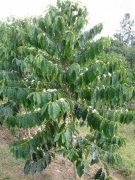The planting temperature of coffee tree is between 15 degrees and 25 degrees.
The origin of the coffee tree is Ethiopia in Africa. In botany, coffee trees belong to the evergreen trees of the subgenus Rubiaceae, and coffee beans, commonly known as coffee beans, are actually the seeds of the fruit of coffee trees. They are called coffee beans only because they are shaped like beans.
Climate is the decisive factor for coffee cultivation. Coffee trees are only suitable for growing in the tropics or subtropics, so the zone between latitude 25 degrees south and north is generally called coffee belt or coffee area. However, not all the land located in this area can produce good coffee trees.
The ideal planting conditions for coffee trees are: the temperature is between 15 degrees and 25 degrees, and the annual rainfall must reach 1500 mm to 2000 mm. At the same time, the rainfall time should be in line with the flowering cycle of coffee trees. Of course, in addition to the seasonal rainfall, there should also be fertile soil and good drainage.
Fertile soil containing volcanic ash, in addition, although sunlight is an indispensable element for the growth and fruit of coffee, too strong sunlight will inhibit the growth of coffee trees, so various producing areas usually cooperate with the planting of some shade trees. The ideal altitude is 500m-2000 m above sea level. It can be seen that the conditions for the cultivation of high-quality coffee are quite strict: sunlight, rainfall, soil, air temperature, as well as the way coffee beans are harvested and the production process will affect the quality of coffee itself.
The first flowering period of the coffee tree is about three years old. the five-petal tube-shaped white flowers are filled with a faint scent of jasmine and the inflorescences are arranged in dense clusters.
Flowers wither after two or three days of blooming and begin to bear fruit after a few months. The fruit is a drupe with a diameter of about 1.5cm. It turns green at first, then turns yellow gradually, and turns red when ripe. It is very similar to cherries, so it is called cherry coffee (CoffeeCherry). It can be harvested at this time.
Coffee fruit contains two seeds, namely coffee beans. The two beans are connected face to face with each other on one side of the plane.
Each coffee bean has a thin outer film, which is called silver skin, and its outer layer is covered with a yellow outer skin, called endocarp.
The whole coffee bean is wrapped in a sticky pulp to form the coffee pulp, which is soft and sweet, with the outer shell.
Growth and characteristics of Coffee
Coffee is a kind of drink that gives the public the impression that it is black, bitter, can not sleep and feel excited. The color of coffee beans we see in the coffee shop is brown, which belongs to roasted coffee beans, while the color of coffee liquid is amber.
Coffee comes from coffee beans, which are harvested and processed from the fruit of trees.
Coffee trees grow at the center of the equator, between latitudes of 25 degrees south and north, and are called the homes of tropical or subtropical countries called coffee belts. At present, there are about 60 coffee-producing countries. Coffee is produced in South America, Central America, the West Indies, Asia, Africa, Arabia, the South Pacific and Oceania. In terms of production, Brazil ranks first in the world, accounting for about 30%. The second is Colombia-centered Central and South America, accounting for 60%. It accounts for about 10 per cent, followed by Africa and Arabia accounting for about 30 per cent, and the remaining 10 per cent are distributed in Asia and most islands.

Coffee tree belongs to the evergreen plant of Akanaceae. It is a tropical plant and is not cold-tolerant. It is mostly grown in areas with an elevation of 2000 jujube and 2500 meters. It is also cultivated in the highland with an elevation of 2000 jujube and 2500 meters, but the quality of the plant on the hillside above 1500 meter is better. Coffee tree is most suitable for growing in an environment where the average temperature is about 20 ℃, the annual precipitation is 1500 jujube 2000 mm, the soil is permeable, and the sunshine is suitable. Coffee is afraid of Frosts Descent and the cold winter, and must not be planted in the highlands where frost falls. In general, wild coffee trees can grow to about 8 meters. In their homes, in order to protect the quality of coffee beans and facilitate management and harvest, the height is cut to 2 meters. Coffee beans begin to bear fruit 3 to 5 years after sowing, and 5 to 20 years is the harvest period. A coffee tree can produce about 3 to 5 kilograms of coffee cherries a year.
At present, coffee trees are mainly planted in Arabica, Robusta and Liberia. The Arabica species produced in Elaraby Sinia (now Ethiopia) has the highest quality of the three major tree species, accounting for 2/3 of the world's coffee production. Coffee beans are oval and flat, characterized by strong aroma and good quality. Robusta is produced in Africa, Congo, strong disease resistance, high temperature resistance, slightly smaller fruit, accounting for 30% of the world output, bitter but not sour, aroma is not very good, most of them are picked into mixed coffee. Liberica is native to Liberia in Africa. It is characterized by light fragrance, strong bitterness, poor quality and poor yield.
A fresh, green coffee bean obtained by removing its red flesh and peel and silver skin from a coffee cherry. The structure of coffee cherry is composed of outer skin, pulp, endocarp, silver skin and seeds. The shape is oval, usually the fruit of coffee is composed of two oval seeds opposite each other and the other side is flat, so it is called flat bean, but there is also a round seed called round bean, which tastes the same.
The color of coffee flowers is white, jasmine fragrance, about three to four days to thank, the flowers show 5 petals, five males and one female (the front split into two). And its cotyledon tip is pointed, the two pieces are relatively grouped, the leaf surface is dark green, the back is light green, oval.
The higher the growth height of coffee beans, the higher the acidity, the higher the price of coffee with proper sour taste, such as Blue Mountain Coffee, which is naturally balanced in sour, sweet and bitter taste and full of flavor.
Coffee has four flavors and one fragrance: aroma, bitterness, sour, mellow, sweetness and aroma are the life of coffee and the best expression of coffee production process and roasting technology.
Coffee beans grow in tropical or subtropical agricultural gardens centered around the equator called coffee belts and travel to Japan with ships. When the brown coffee beans appear in front of your eyes, they have actually gone through a variety of different circulation processes and the hands of many people.
Coffee is widely produced in South America, Central America, the West Indies, Asia, Africa, Alapa, the South Pacific and Oceania. In terms of production, Brazil ranks first in world output (about 30%), followed by Central and South America with Colombia (about 10%) as the center, accounting for 60%, followed by Africa and Arabia accounting for about 30%. The remaining 10% are distributed in Asian countries and most islands.
At present, there are about 60 coffee-producing countries, most of which are located in areas with an elevation of 300 meters and 400 meters, and sometimes coffee trees are cultivated on highlands with elevations of 2000 meters and 2,500 meters, but those planted on slopes above 1500 meters above sea level are said to be of better quality.
The most suitable conditions for the cultivation of coffee trees are areas with an average annual rainfall of 1500murmur2000 meters and an average temperature of about 20 degrees, which will not defrost.
Important Notice :
前街咖啡 FrontStreet Coffee has moved to new addredd:
FrontStreet Coffee Address: 315,Donghua East Road,GuangZhou
Tel:020 38364473
- Prev

A real picture of the harvest process from coffee tree to coffee fruit
The coffee tree is more than 3 meters tall. Coffee flowers white flowers, beautiful like magnolia, but life is short, it will wither after 3 days! After the coffee beans are in full bloom, the coffee beans turn from green to red and when the fruit is bright red and ripe, you can begin to pick and harvest the fruit, remove the skin, soak it in water for 12 to 16 hours, and then wash it. Remove the peel of coffee beans
- Next

Coffee growing habits Coffee trees belong to the Akanaceae evergreen family
Coffee trees belong to the evergreen family of the Akanaceae family. They are tropical plants and are not cold-resistant. Most of them are planted in areas with an elevation of 300-400 meters. There are also highlands cultivated at elevations of 2000-2500 meters. However, the quality of those planted on slopes above 1500 meters is better. Coffee trees grow best at an average temperature of about 20 degrees Celsius and annual precipitation of 1500-2000 millimeters
Related
- Beginners will see the "Coffee pull flower" guide!
- What is the difference between ice blog purified milk and ordinary milk coffee?
- Why is the Philippines the largest producer of crops in Liberia?
- For coffee extraction, should the fine powder be retained?
- How does extracted espresso fill pressed powder? How much strength does it take to press the powder?
- How to make jasmine cold extract coffee? Is the jasmine + latte good?
- Will this little toy really make the coffee taste better? How does Lily Drip affect coffee extraction?
- Will the action of slapping the filter cup also affect coffee extraction?
- What's the difference between powder-to-water ratio and powder-to-liquid ratio?
- What is the Ethiopian local species? What does it have to do with Heirloom native species?

